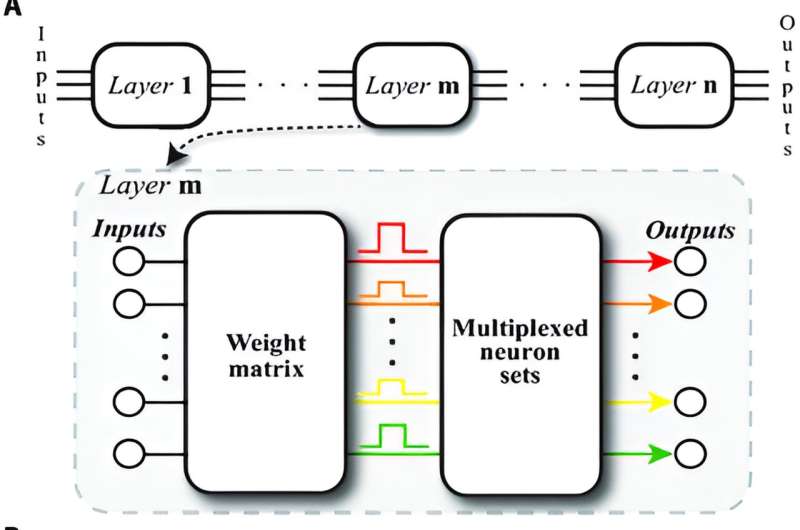
Seeking to improve the practicality of optical neural networks that use wavelength division multiplexing, a research team developed a structure called multiplexed neuron sets and a corresponding backpropagation training algorithm.
Using these, they were able to reduce the size of the network and thus improve energy efficiency by a factor of 10 while achieving performance comparable to that of a traditional optical neural network trained with a traditional algorithm. Their research was published Feb. 20, 2024 in Intelligent Computing.
Optical neural networks are much more energy-efficient than conventional artificial neural networks, which require massive amounts of computational power and thus consume large amounts of energy. However, crosstalk between channels decreases performance in optical systems that use wavelength division multiplexing for parallelization.
Wavelength division multiplexing is a method for transmitting more information through the same connection at the same time using signals of different wavelengths. These different wavelengths are different signal channels.
Previously, combinations of channels have been used for performing vector-matrix multiplication for optical neural networks. In this research, multiplexed neuron sets are being used to compress the summation and nonlinear activation functions belonging to multiple neurons.
The functions of the set of neurons are encoded on different signal channels and can thus be implemented by a nonlinear optical device with inputs of multiple wavelengths, and a network of multiple layers can be built using a series of these optical devices.

Unfortunately, signals in adjacent channels still interfere with each other, resulting in noisy signals. To reduce this interchannel crosstalk and the resulting potential for computation errors, a new backpropagation training algorithm that takes crosstalk into consideration was designed.
Performance was assessed for the multiplexed neuron set architecture with the new backpropagation algorithm using classification tasks with handwritten digits and fashion images. The new method was found to have a greater performance advantage when the amount of multiplexing increases.
Similarly, theoretical analysis of power consumption showed that a multiplexed neuron set implementation of a network has a greater efficiency advantage when the amount of multiplexing increases.
The researchers implemented their method using semiconductor optical amplifiers, which are commercially mature devices, but their work is “demonstrated at a highly abstract level” and thus is relevant for other photonic devices with similar characteristics, as well as for AI-assisted optical signal processing with interchannel crosstalk.
More information:
Yi-Feng Liu et al, Slimmed Optical Neural Networks with Multiplexed Neuron Sets and a Corresponding Backpropagation Training Algorithm, Intelligent Computing (2023). DOI: 10.34133/icomputing.0070
Intelligent Computing
Multiplexed neuron sets make smaller optical neural networks possible (2024, May 6)
retrieved 6 May 2024
from https://techxplore.com/news/2024-05-multiplexed-neuron-smaller-optical-neural.html
part may be reproduced without the written permission. The content is provided for information purposes only.

Seeking to improve the practicality of optical neural networks that use wavelength division multiplexing, a research team developed a structure called multiplexed neuron sets and a corresponding backpropagation training algorithm.
Using these, they were able to reduce the size of the network and thus improve energy efficiency by a factor of 10 while achieving performance comparable to that of a traditional optical neural network trained with a traditional algorithm. Their research was published Feb. 20, 2024 in Intelligent Computing.
Optical neural networks are much more energy-efficient than conventional artificial neural networks, which require massive amounts of computational power and thus consume large amounts of energy. However, crosstalk between channels decreases performance in optical systems that use wavelength division multiplexing for parallelization.
Wavelength division multiplexing is a method for transmitting more information through the same connection at the same time using signals of different wavelengths. These different wavelengths are different signal channels.
Previously, combinations of channels have been used for performing vector-matrix multiplication for optical neural networks. In this research, multiplexed neuron sets are being used to compress the summation and nonlinear activation functions belonging to multiple neurons.
The functions of the set of neurons are encoded on different signal channels and can thus be implemented by a nonlinear optical device with inputs of multiple wavelengths, and a network of multiple layers can be built using a series of these optical devices.

Unfortunately, signals in adjacent channels still interfere with each other, resulting in noisy signals. To reduce this interchannel crosstalk and the resulting potential for computation errors, a new backpropagation training algorithm that takes crosstalk into consideration was designed.
Performance was assessed for the multiplexed neuron set architecture with the new backpropagation algorithm using classification tasks with handwritten digits and fashion images. The new method was found to have a greater performance advantage when the amount of multiplexing increases.
Similarly, theoretical analysis of power consumption showed that a multiplexed neuron set implementation of a network has a greater efficiency advantage when the amount of multiplexing increases.
The researchers implemented their method using semiconductor optical amplifiers, which are commercially mature devices, but their work is “demonstrated at a highly abstract level” and thus is relevant for other photonic devices with similar characteristics, as well as for AI-assisted optical signal processing with interchannel crosstalk.
More information:
Yi-Feng Liu et al, Slimmed Optical Neural Networks with Multiplexed Neuron Sets and a Corresponding Backpropagation Training Algorithm, Intelligent Computing (2023). DOI: 10.34133/icomputing.0070
Intelligent Computing
Multiplexed neuron sets make smaller optical neural networks possible (2024, May 6)
retrieved 6 May 2024
from https://techxplore.com/news/2024-05-multiplexed-neuron-smaller-optical-neural.html
part may be reproduced without the written permission. The content is provided for information purposes only.







